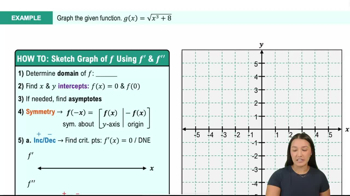Table of contents
- 0. Functions7h 52m
- Introduction to Functions16m
- Piecewise Functions10m
- Properties of Functions9m
- Common Functions1h 8m
- Transformations5m
- Combining Functions27m
- Exponent rules32m
- Exponential Functions28m
- Logarithmic Functions24m
- Properties of Logarithms34m
- Exponential & Logarithmic Equations35m
- Introduction to Trigonometric Functions38m
- Graphs of Trigonometric Functions44m
- Trigonometric Identities47m
- Inverse Trigonometric Functions48m
- 1. Limits and Continuity2h 2m
- 2. Intro to Derivatives1h 33m
- 3. Techniques of Differentiation3h 18m
- 4. Applications of Derivatives2h 38m
- 5. Graphical Applications of Derivatives6h 2m
- 6. Derivatives of Inverse, Exponential, & Logarithmic Functions2h 37m
- 7. Antiderivatives & Indefinite Integrals1h 26m
- 8. Definite Integrals4h 44m
- 9. Graphical Applications of Integrals2h 27m
- 10. Physics Applications of Integrals 2h 22m
5. Graphical Applications of Derivatives
Curve Sketching
Problem 4.4.11
Textbook Question
Sketch a continuous function f on some interval that has the properties described. Answers will vary.
The function f satisfies f'(-2) = 2, f'(0) = 0, f'(1) = -3 and f'(4) = 1.
 Verified step by step guidance
Verified step by step guidance1
Understand that f'(x) represents the derivative of the function f(x), which gives the slope of the tangent line to the curve at any point x. The given values of f'(x) indicate the slope of the function at specific points.
At x = -2, f'(-2) = 2, which means the slope of the tangent line to the function at x = -2 is 2. This suggests that the function is increasing at this point.
At x = 0, f'(0) = 0, indicating that the slope of the tangent line is zero. This typically means there is a horizontal tangent line at this point, suggesting a local maximum or minimum.
At x = 1, f'(1) = -3, which means the slope of the tangent line is -3. This indicates that the function is decreasing at this point.
At x = 4, f'(4) = 1, indicating that the slope of the tangent line is 1. This suggests that the function is increasing at this point. Use these slopes to sketch a function that transitions smoothly through these points, ensuring continuity.
 Verified video answer for a similar problem:
Verified video answer for a similar problem:This video solution was recommended by our tutors as helpful for the problem above
Video duration:
3mPlay a video:
Was this helpful?
Key Concepts
Here are the essential concepts you must grasp in order to answer the question correctly.
Derivative
The derivative of a function at a point measures the rate at which the function's value changes as its input changes. It is represented as f'(x) and provides information about the function's slope at that specific point. Understanding the values of the derivative at given points helps in determining the function's behavior, such as increasing or decreasing intervals.
Recommended video:

Derivatives
Critical Points
Critical points occur where the derivative of a function is zero or undefined. These points are significant because they can indicate local maxima, minima, or points of inflection. In the context of the given question, f'(0) = 0 suggests a critical point, which is essential for sketching the function and understanding its overall shape.
Recommended video:

Critical Points
Continuity
A function is continuous on an interval if there are no breaks, jumps, or holes in its graph. This property ensures that the function can be drawn without lifting the pencil from the paper. For the function f in the question, being continuous means that it must smoothly connect the points defined by the derivative values, influencing how the function is sketched across the specified interval.
Recommended video:

Intro to Continuity

 11:41m
11:41mWatch next
Master Summary of Curve Sketching with a bite sized video explanation from Callie
Start learning




